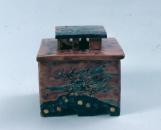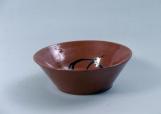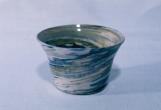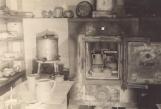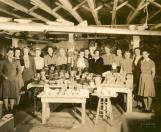1
Alice Hagen ''Coil Pot'' (no date) glazed earthenware1940
 Credits:
Credits:Photo courtesy of Nova Scotia Museum
4
Alice Hagen's pottery techniquesAlice Hagen used a variety of construction and decorative techniques in her pottery. Some pieces were thrown on a wheel; some were decorated with shapes cut from rolled slabs of clay. Some of the shapes were slip cast. Slip-casting is a method of making copies of an object. A mould is taken of the original form in plaster. Slip (a clay and water mixture) is poured into the mould and left to allow the plaster to absorb the water. After the excess water has been poured off, the result is a shell of clay that has the same shape as the original object. Alice Hagen made extensive use of moulds simple forms that could be quickly produced. She also used slab and coil building and hand-tooling on the wheel.
7
Scotian Pebble wareAlice Hagen is especially well-known for her distinctive Scotian pebble ware. In Pebble ware the processes of construction and decoration are combined. The variegated colours of these pieces are not surface decoration, but are the clay itself. The effect is achieved by kneading clays of different colours together to integrate the clay bodies, but not to blend the colours. These thrown pieces show striations of colour on the inside and the outside.
Hagen claimed that, "Scotian pebble is tricky to make. It's a matter of colouring the clays first and then moulding them, very quickly and expertly. You must do it right first time, or the colours will mix too much and turn muddy." (1)
(1) Kay Hill, "Nova Scotia's Pioneer Potter: Alice Mary Hagen of Mahone Bay," Atlantic Advocate, August 1959, pp. 43-47.
8
Art for childrenBy 1936 Alice Egan Hagen was well established in her new community and her pottery studio, and was gaining the attention of local educators. In October she was invited to address the Lunenburg-Queens teachers institute in Bridgewater to talk about "Art in the Lower Grades." Not surprisingly Hagen believed that art education for children, especially those aged seven to 13, was vitally important. "Learning to draw," she told the assembled teachers, "is learning to see." In her promotion of art education Hagen was within a longstanding nineteenth-century educational tradition which associated learning to draw with the development of basic skills such as hand-eye co-ordination and scientific observation. Hagen, however, took this idea a step further, urging teachers to "free the creative power of the individual. Nearly everybody is endowed with the creative instinct. The problem is to release it." The outcome of releasing children's creativity is a happier life. Pottery, she argued, was especially well suited to releasing creativity. "One of the simplest means of awakening the creative instinct is the use of clay. We yield to a natural instinctive influence when we give ourselves up to the art of modelling - taking the clay in our hands and moulding some simple object." She went on to say:
"The greatest thing in every man or woman is that spark of the Divine which we call creative imagination. This is every child's heritage, and we, the teachers, should do everything in our power to give the child the inspiration that will awaken that spark and develop it." (1)
Hagen rarely wrote about her work or her approach to it. Her talk to the teachers' institute gives us a glimpse of her understanding of the role of art in her own life. (2)
(1) J.C. Hagen, "Art in the Lower Grades," Journal of Education (NS) (1936) : pp. 906-09.
(2) J.C. Hagen, "Art in the Lower Grades," Journal of Education (NS) (1936) : pp. 906-09.
10
Students in Mahone Bay studioAlice Egan Hagen used her Mahone Bay studio for teaching as well as for making her own work. She, herself, was eager to spread her pottery skills very widely -- teaching had always been part of her plan as she developed her knowledge and technique. In 1938 the Technical Branch of the Nova Scotia Department of Education began certifying Alice Hagen's courses -- after the successful completion of three years of part-time, classes students received a certificate of competency. She also began teaching regular three-year summer courses in Mahone Bay, Lantz and Antigonish, again under the aegis of the Technical Branch. Frederic Sexton, president of the Technical College (now Dal-Tech), Henry Monro, the Superintendent of Education, and later E.K. Ford, Director of Vocational Training in Nova Scotia, gave her invaluable co-operation, and the summer classes were soon supplemented by winter ones open to teachers who could carry the craft back to their pupils.(1)
(1) Hill, "Nova Scotia's Pioneer Potter."
12
Summer school at AntigonishIn the summer of 1941 Alice Egan Hagen directed a pottery summer school at Mount St. Bernard College in Antigonish, Nova Scotia. The three-year program was arranged by E.K. Ford, inspector of technical schools for Nova Scotia, who felt the program did "splendid work." Students in the first year were shown how to prepare clay for use; soaking it, forcing it through a sieve to remove grit, drying it, and kneading it to remove air bubbles (technically known as "wedging"). They were shown the various ways in which pottery is built and finished and how it is dried before being ready for firing. In their second summer, students learned the more advanced modelling and design, and in the third year students worked on the wheel to throw pots and on glazing. Hagen believed the school was very successful, and hoped that she would be able to find more instructors for the following year. While Hagen was well aware of the economic side of pottery making, whether for home use of for sale, she felt strongly that the work was important from the cultural point of view: "it trains the touch and eye and brings out unsuspected creative faculties. I have never seen happier people at work." (1)
(1) Unidentified newspaper clipping, 8 October 1941, from the files of the Settlers' Museum, Mahone Bay, N.S.
14
Cooperatives and adult educationThe Extension Department of St. Francis Xavier University (StFX) in Antigonish became very actively involved in adult education, the development of production and consumer cooperatives and community development in the 1930s under the leadership of Father Moses Coady and Father Jimmy Thompkins. One facet of this work, strongly associated with Catholic social reform in the first half of the 20th century, was the promotion and development of handcraft skills. The movement saw handcrafts as fitting within its grassroots vision of cooperative development.1 Hagen's work as a teacher of pottery ensured a comfortable fit with the Extension Department's programs.
(1) Ian McKay, The Quest of the Folk: Antimodernism and Cultural Selection in Twentieth-Century Nova Scotia (Montreal and Kingston: McGill-Queens University Press, 1994), p. 163.
